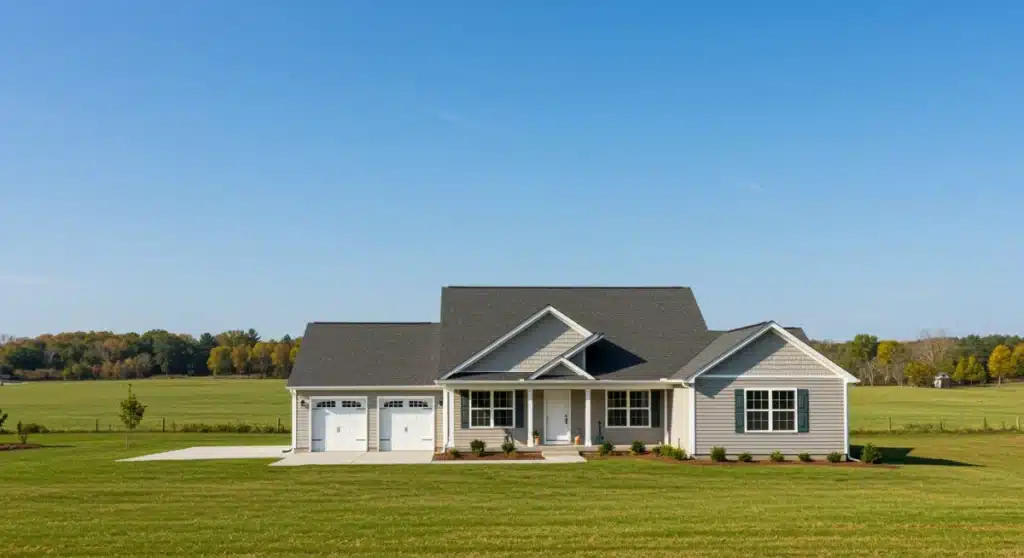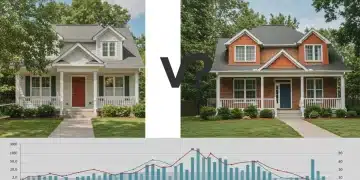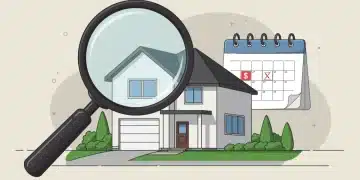USDA Loan Program 2025: 100% Financing for Rural Homes

The USDA Loan Program 2025 offers 100% financing for eligible rural homebuyers, providing a critical path to affordable homeownership in designated areas across the United States.
The USDA Loan Program in 2025: Understanding Eligibility for 100% Financing in Rural Areas remains a cornerstone for aspiring homeowners seeking to purchase properties outside major metropolitan centers. This vital federal initiative continues to provide zero-down payment options, making homeownership attainable for many who might otherwise face significant financial hurdles. As we approach 2025, understanding the specific eligibility requirements and program nuances is crucial for potential applicants.
Understanding the USDA Loan Program Fundamentals
The United States Department of Agriculture (USDA) Rural Development loan program, officially known as the Single Family Housing Guaranteed Loan Program, is designed to assist low- and moderate-income individuals in purchasing safe and sanitary housing in eligible rural areas. This program is particularly attractive due to its 100% financing option, eliminating the need for a down payment, a significant barrier for many first-time homebuyers.
As of late 2024, the program’s core principles remain consistent for 2025. It guarantees loans made by approved lenders, reducing risk and encouraging financial institutions to offer favorable terms to qualified borrowers. This guarantee is a key differentiator from conventional loans, which typically require a substantial down payment.
Key Benefits of USDA Loans
The advantages of securing a USDA loan extend beyond just the no-down-payment feature. Borrowers often benefit from competitive interest rates, which are frequently lower than those found in conventional loan markets. This is due to the government backing, which stabilizes the lending environment.
- No Down Payment: A zero-down payment requirement makes homeownership accessible without needing years of savings.
- Lower Interest Rates: Government guarantees often translate to more favorable interest rates from lenders.
- Flexible Credit Guidelines: While credit scores are important, USDA guidelines can be more lenient than conventional loans, considering the overall financial picture.
- Reduced Mortgage Insurance: Although there is an upfront guarantee fee and an annual fee, these are generally lower than private mortgage insurance (PMI) on conventional loans with low equity.
Eligibility Requirements for Borrowers in 2025
Eligibility for the USDA Loan Program in 2025 hinges on several factors, primarily income and creditworthiness. The USDA sets specific income limits based on the median income for the area, adjusted for family size. These limits are updated annually, and prospective applicants should verify the latest figures for their specific location.
Applicants must demonstrate a reliable repayment ability, which involves a stable income history and a manageable debt-to-income ratio. While there isn’t a strict minimum credit score, lenders typically look for scores in the mid-600s or higher. However, exceptions can be made for applicants with non-traditional credit histories or extenuating circumstances, provided they can prove an ability to manage financial obligations responsibly.
Income Limits and Family Size
The USDA updates its income limits yearly, usually around May or June. These limits vary significantly by county and the number of dependents in a household. For instance, a four-person household in one rural area might have a higher income limit than a two-person household in another, reflecting local economic conditions and cost of living. It is critical for applicants to check the official USDA website or consult with an approved USDA lender for the most current figures relevant to their specific situation.
Credit Score and Debt-to-Income Ratio
While a minimum credit score is not officially published by the USDA, most lenders require a score of at least 640 for streamlined processing. Applicants with lower scores may still qualify but might need to undergo a more thorough underwriting process, providing additional documentation to demonstrate financial stability. The debt-to-income (DTI) ratio is also a key factor; generally, the USDA looks for a DTI of 29%/41% (housing expenses / total debt), though some flexibility exists for strong applicants.
Property Eligibility: What Qualifies for USDA Financing?
Not all properties are eligible for the USDA Loan Program in 2025. The single most important criterion is that the property must be located within a designated rural area as defined by the USDA. These areas are typically outside the boundaries of major cities and towns, though some smaller communities adjacent to urban centers may still qualify. The USDA provides an online eligibility map where prospective buyers can verify specific addresses.
Beyond geographical location, the property itself must meet certain standards. It must be modest in size, design, and cost for the area, and it must be safe, sanitary, and structurally sound. The loan is intended for primary residences only; investment properties or second homes are not eligible. Additionally, the property should not have an in-ground swimming pool, as this is typically deemed a luxury item by the USDA.
Defining Rural Areas
The definition of a ‘rural area’ for USDA loan purposes is broader than many people assume. It often includes towns and communities with populations of up to 35,000 residents, provided they are not closely associated with an urban area. The USDA’s eligibility map is the definitive tool for checking specific addresses, as boundaries can change with population shifts and new census data. It’s not just about farmland; many suburban-like communities can qualify.

Property Condition and Use
The property must be in good repair and meet all local codes and USDA minimum property standards. This usually involves an appraisal and inspection process to ensure the home is safe, sanitary, and structurally sound. The loan is designed to help families secure a primary residence, meaning the borrower must occupy the home as their principal dwelling. This excludes rental properties, vacation homes, or commercial ventures.
The Application Process for USDA Loans in 2025
Applying for a USDA Loan Program in 2025 involves several steps, similar to other mortgage applications, but with specific USDA requirements. The first step is to find an approved lender. Not all banks or mortgage companies offer USDA loans, so it’s essential to work with one that specializes in this program. These lenders are familiar with the specific documentation and underwriting processes required by the USDA.
Once a lender is chosen, applicants will undergo pre-qualification or pre-approval, where their income, credit, and debt are assessed to determine their eligibility and potential loan amount. This typically involves submitting financial documents such as pay stubs, tax returns, and bank statements. After pre-approval, the house-hunting process begins within the eligible rural areas. Once a property is identified, the full application and underwriting process commences, including an appraisal and inspection to ensure the property meets USDA standards.
Finding an Approved Lender
The USDA does not directly lend money for the Guaranteed Loan Program; instead, it guarantees loans made by private financial institutions. Therefore, finding a lender approved to originate USDA loans is crucial. Many national and regional banks, credit unions, and mortgage brokers participate in the program. Online searches or inquiries with local real estate agents specializing in rural properties can help identify suitable lenders.
Documentation and Underwriting
The application typically requires extensive documentation to verify income, assets, and liabilities. This includes recent pay stubs, W-2 forms, tax returns for the past two years, bank statements, and any documentation related to other debts. The underwriting process involves a thorough review of all submitted documents to ensure the borrower meets all USDA and lender-specific criteria. This can take several weeks, so patience is key.
Changes and Updates Expected for 2025
While the core structure of the USDA Loan Program in 2025 is expected to remain consistent, annual adjustments are common. These often include updates to income limits, changes to the guarantee fees, and modifications to eligible rural areas based on new census data. Prospective applicants should monitor official USDA announcements closely as the year progresses to stay informed of any new developments.
Changes in guarantee fees, both upfront and annual, can impact the overall cost of the loan. Historically, these fees have been relatively low compared to other government-backed loans. Additionally, as urban sprawl continues, some areas previously designated as rural might be reclassified, affecting property eligibility. Conversely, new areas might become eligible, expanding opportunities for rural homeownership.
Anticipated Adjustments to Income Limits
Income limits are perhaps the most frequently updated aspect of the USDA loan program. These adjustments are made to reflect changes in local median incomes and inflation. Keeping an eye on the USDA Rural Development website for these annual updates is essential. Typically, these changes are announced in the spring or early summer, impacting applications submitted after the effective date.
Potential Revisions to Rural Area Definitions
With each new census and ongoing demographic shifts, the USDA periodically reviews and updates its rural eligibility maps. This means an area considered rural today might not be in 2025, or vice-versa. It is imperative to check the property eligibility map with the most current data available when considering a specific location for purchase.
Common Misconceptions About USDA Loans
Many misconceptions surround the USDA Loan Program in 2025, often leading potential borrowers to overlook this valuable financing option. One common myth is that USDA loans are only for agricultural properties or farms. In reality, the program is primarily for single-family homes in designated rural areas, which can include suburban-like communities, not just working farms. Another misconception is that only first-time homebuyers qualify; while many are first-time buyers, the program is open to anyone who meets the income and property eligibility requirements, regardless of prior homeownership.
Some believe that the application process is overly complicated or takes too long. While it does involve specific steps, working with an experienced USDA-approved lender can streamline the process, making it comparable to other mortgage applications. Understanding these truths can help more individuals leverage this powerful tool for homeownership.
Not Just for Farms
The ‘Agriculture’ in USDA often misleads people to believe the loans are exclusively for farming. However, the program supports general housing needs in rural communities, fostering economic development and stable populations outside of major urban centers. Eligible properties range from manufactured homes (meeting specific criteria) to traditional stick-built houses.
Not Limited to First-Time Homebuyers
While often utilized by first-time homebuyers due to the no-down-payment feature, the USDA loan program does not have a first-time homebuyer requirement. Any eligible applicant who meets the income and property criteria can apply, even if they have owned a home before. The key is that the new property must serve as their primary residence.
| Key Point | Brief Description |
|---|---|
| 100% Financing | The USDA Loan Program 2025 offers no down payment requirements for eligible borrowers, making homeownership more accessible. |
| Rural Area Eligibility | Properties must be located in USDA-designated rural areas, which can include communities up to 35,000 residents. |
| Income Limits | Borrowers must meet specific income limits, updated annually based on county and family size, to qualify for the program. |
| Primary Residence Only | The loan is exclusively for purchasing a primary residence; investment properties or second homes are not eligible. |
Frequently Asked Questions About USDA Loans
The primary advantage of a USDA loan is 100% financing, meaning no down payment is required. Additionally, borrowers often benefit from lower interest rates and reduced mortgage insurance costs compared to conventional loans, making homeownership more affordable for eligible rural residents.
You can check property eligibility using the USDA’s official online eligibility map. Simply input the address, and the map will indicate if the location falls within a designated rural area for the Single Family Housing Guaranteed Loan Program. Boundaries are subject to annual updates.
While the USDA does not publish a strict minimum, most approved lenders look for a credit score of at least 640 for streamlined processing. Applicants with lower scores may still qualify but might require a more in-depth review of their financial history and repayment ability.
No, the USDA Loan Program is strictly for purchasing a primary residence. The borrower must intend to occupy the home as their principal dwelling. Investment properties, vacation homes, or commercial properties are not eligible under this program’s guidelines.
USDA income limits are updated annually, typically around late spring or early summer, and vary by county and family size. The most current information can be found on the official USDA Rural Development website or by consulting with an approved USDA loan lender.
What Happens Next
As 2025 approaches, prospective rural homebuyers should actively engage with approved USDA lenders to ascertain their eligibility under the latest guidelines. The program’s continuity provides a stable avenue for homeownership, but evolving economic conditions and demographic shifts could influence future adjustments to income thresholds and rural area designations. Staying informed through official USDA channels and expert financial advisors will be paramount for those looking to leverage the significant benefits of the USDA Loan Program.





